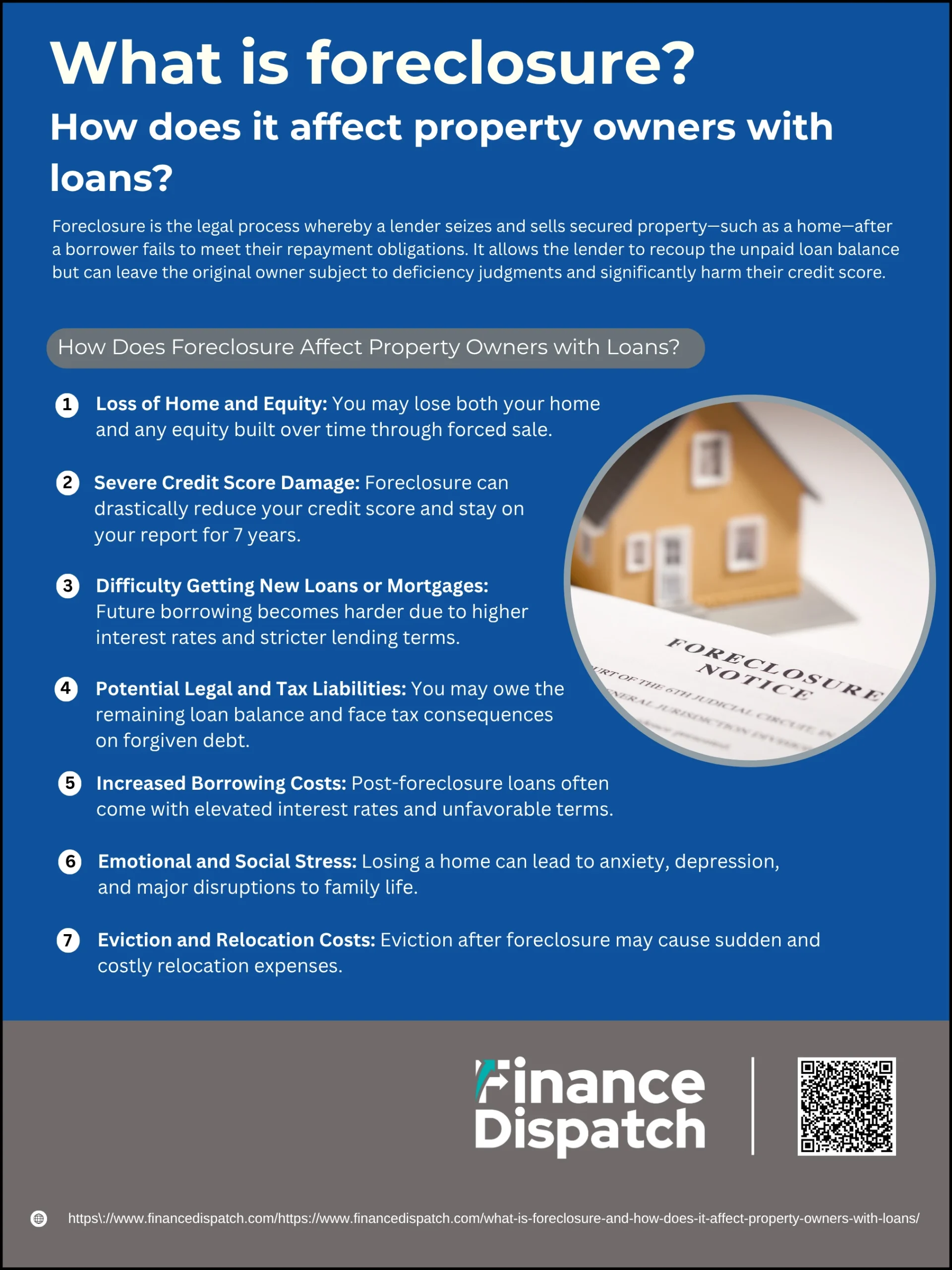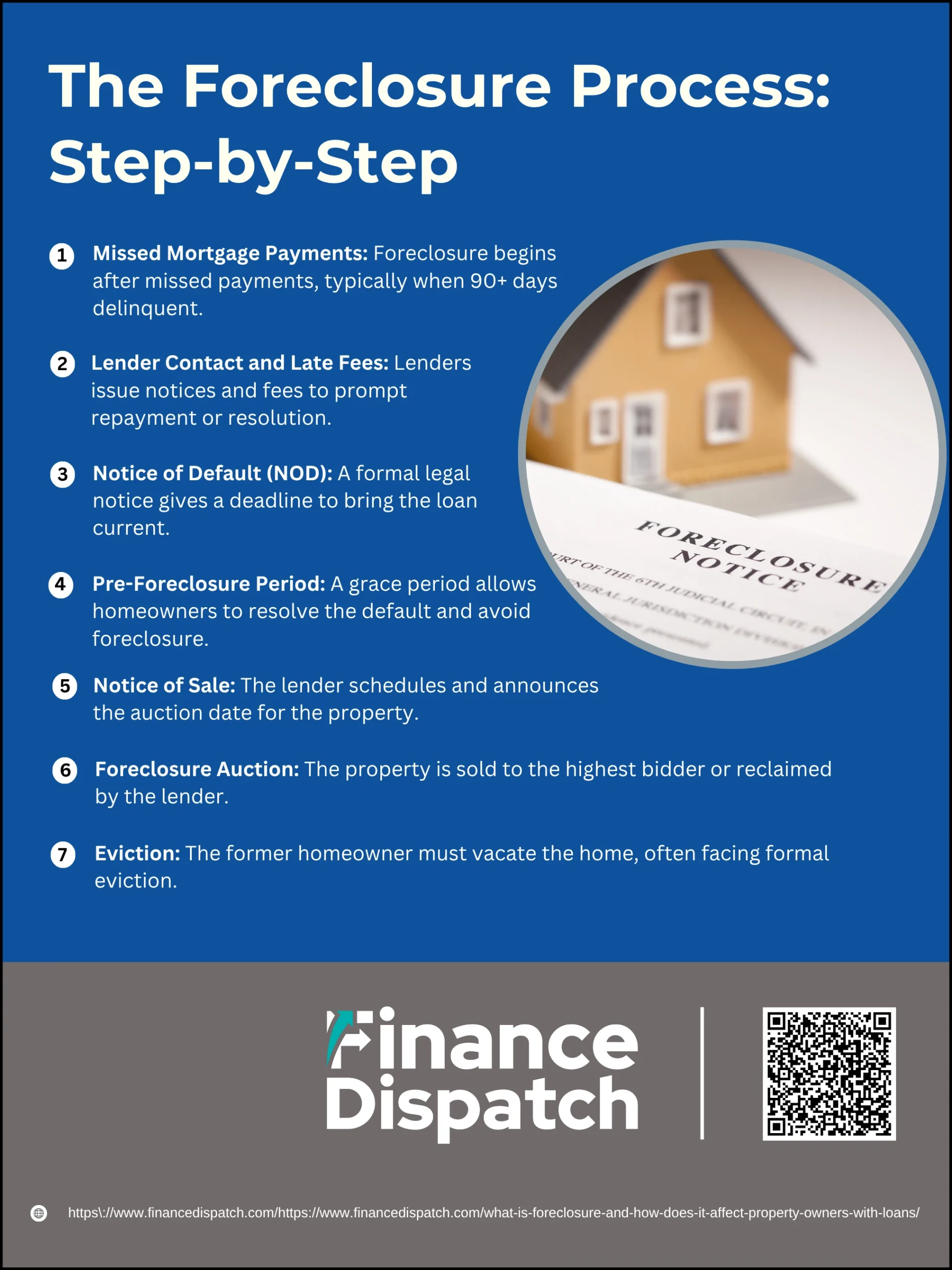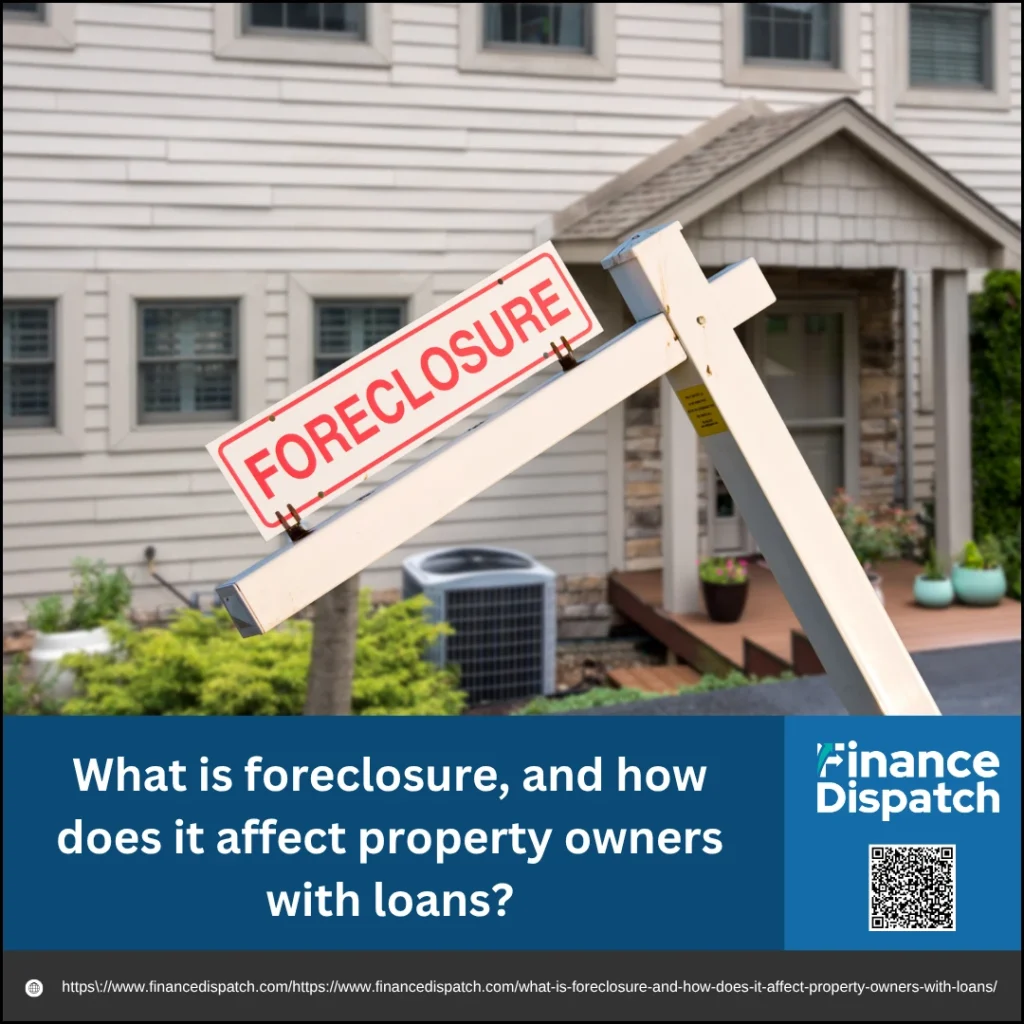Foreclosure is one of the most distressing situations a homeowner can face. It occurs when a borrower fails to meet their mortgage obligations, prompting the lender to legally seize and sell the property to recover the outstanding loan amount. While the foreclosure process varies by state and loan terms, its consequences are often severe and far-reaching. For property owners with loans, foreclosure not only means the potential loss of their home but also long-term financial and emotional repercussions. Understanding what foreclosure is—and how it can impact you—is essential to protecting your investment and financial future.
What is Foreclosure?
Foreclosure is a legal process that occurs when a property owner fails to make required mortgage payments, leading the lender to take ownership of the property and sell it to recover the unpaid loan balance. When you take out a mortgage, your home serves as collateral, giving the lender the right to foreclose if you default on the loan. This process typically begins after several missed payments and involves formal notices, legal procedures, and eventually the sale or auction of the property. Foreclosure laws and timelines vary by state, but the outcome is often the same: the homeowner loses the property, and the lender attempts to minimize its financial loss through resale.
 How Does Foreclosure Affect Property Owners with Loans?
How Does Foreclosure Affect Property Owners with Loans?
Foreclosure is more than just the legal loss of a home—it’s a life-altering event that can derail a homeowner’s financial stability, credit standing, and emotional well-being. For property owners still paying off a mortgage, foreclosure represents the collapse of a major investment and the start of long-term recovery challenges. The impact reaches far beyond losing a physical structure; it affects future borrowing power, living arrangements, and even mental health. Understanding these effects is essential for anyone facing financial hardship or wanting to protect their homeownership.
1. Loss of Home and Equity
Foreclosure results in the forced sale of your home, often through an auction. Any equity you’ve built over the years—whether through monthly payments or rising property values—is likely to be lost. If the sale doesn’t cover the loan balance, you walk away with nothing, despite years of investment.
2. Severe Credit Score Damage
A foreclosure can slash your credit score by 100 to 160 points or more, depending on your initial score. This negative mark remains on your credit report for seven years, making it difficult to qualify for loans, credit cards, or rental housing. Rebuilding your credit can take years of consistent financial discipline.
3. Difficulty Getting New Loans or Mortgages
Most lenders are hesitant to approve loans for individuals with a foreclosure on record. Even if approved, you may face stricter terms—such as higher interest rates or larger down payments—making homeownership harder to regain in the near future.
4. Potential Legal and Tax Liabilities
If your foreclosed home is sold for less than what you owe, the lender may pursue a deficiency judgment for the remaining balance, depending on state laws. Additionally, forgiven debt may be treated as taxable income by the IRS, creating an unexpected tax burden unless you qualify for exemption under the Mortgage Forgiveness Debt Relief Act or similar provisions.
5. Increased Borrowing Costs
After foreclosure, any future loans you do qualify for—whether for a car, business, or education—will likely come with elevated interest rates and unfavorable terms, costing you more over time and limiting financial flexibility.
6. Emotional and Social Stress
Losing your home can be traumatic. It disrupts your sense of stability, uproots your family, and may lead to feelings of shame, anxiety, or depression. Children may be forced to change schools, and the loss of community ties can add to the emotional strain.
7. Eviction and Relocation Costs
Once foreclosure is complete, the new owner—whether a bank or third party—can initiate eviction proceedings. You may be given only days or weeks to move out, incurring sudden moving expenses, security deposits for new housing, and temporary housing costs, all while coping with financial distress.
Why Does Foreclosure Happen?
Foreclosure doesn’t occur overnight—it’s typically the result of ongoing financial struggles or unexpected life events that prevent a homeowner from keeping up with mortgage payments. Since a mortgage loan uses the home as collateral, failing to meet repayment obligations gives the lender the legal right to take back the property. Understanding the common reasons behind foreclosure can help homeowners recognize early warning signs and take proactive steps to avoid it.
Here are the most common reasons foreclosure happens:
1. Job Loss or Reduced Income
Losing a job or experiencing a significant drop in income can quickly make monthly mortgage payments unaffordable.
2. Medical Emergencies and Health Issues
Sudden medical expenses or chronic health problems can drain savings and disrupt a homeowner’s ability to work and pay bills.
3. Unexpected Expenses
Major car repairs, home damage, or legal costs can strain finances and lead to missed payments.
4. Poor Financial Planning or Overspending
Taking on too much debt or living beyond one’s means can result in an inability to keep up with loan obligations.
5. Divorce or Separation
Relationship breakdowns often lead to a loss of shared income or increased financial burden on a single person, making it difficult to cover the mortgage.
6. Death of a Spouse or Co-Borrower
The loss of a primary income earner can cause immediate financial hardship, especially if life insurance or estate planning isn’t in place.
7. Adjustable-Rate Mortgage Resets
When introductory interest rates increase, monthly payments can rise sharply, making them unaffordable for some borrowers.
8. Property Value Decline
If the home’s market value drops below the mortgage balance (also known as being “underwater”), homeowners may feel trapped or unwilling to continue paying.
9. Rising Living Costs or Inflation
Increases in utility bills, groceries, and property taxes can reduce the funds available for mortgage payments.
10. Failure to Pay Property Taxes or Insurance
Even if mortgage payments are current, neglecting taxes or homeowners insurance can lead to default and foreclosure by the lender.
 The Foreclosure Process: Step-by-Step
The Foreclosure Process: Step-by-Step
Foreclosure is the legal means by which a lender reclaims a property when the borrower fails to meet their mortgage obligations. Though it’s a difficult process for any homeowner, understanding how foreclosure works can provide clarity and reveal opportunities to stop or delay it. The timeline and specific procedures can vary based on state laws and whether the foreclosure is judicial (involving the courts) or nonjudicial (handled outside of court). However, most foreclosures follow a general pattern. Knowing each stage in advance can help homeowners take action before it’s too late.
Here is a detailed step-by-step breakdown of the foreclosure process:
1. Missed Mortgage Payments
Foreclosure usually begins after a homeowner misses one or more monthly mortgage payments. While a single missed payment may result only in a late fee, repeated delinquency—typically 90 days or more—signals default and raises red flags for the lender.
2. Lender Contact and Late Fees
After each missed payment, the lender will start sending notices, making phone calls, and possibly charging late fees. This early phase is meant to encourage the borrower to catch up or reach out for assistance. If ignored, the situation escalates.
3. Notice of Default (NOD)
Around the 90-day mark, the lender formally issues a Notice of Default. This legal document states that the borrower has defaulted on the mortgage and outlines the amount due to bring the loan current. It also gives a deadline—often 30 days—to resolve the issue before further action is taken.
4. Pre-Foreclosure Period
The pre-foreclosure phase gives the borrower a final window of opportunity to avoid losing the home. During this time, homeowners may catch up on missed payments, request a loan modification, enter forbearance, refinance the loan, or negotiate a short sale. This period is crucial for those seeking to avoid foreclosure.
5. Notice of Sale
If no resolution is reached, the lender files and posts a Notice of Sale. This notice sets a date for the foreclosure auction and is typically mailed to the borrower, posted on the property, and published in public records or newspapers as required by state law.
6. Foreclosure Auction
On the scheduled date, the property is auctioned off to the highest bidder—usually for cash or certified funds. If the highest bid covers the outstanding mortgage, the proceeds go to the lender. If the auction fails to yield a buyer, the lender takes ownership and classifies the property as Real Estate Owned (REO).
7. Eviction
Once the property has been sold, the former homeowner may be given a set number of days to vacate the premises. If they don’t leave voluntarily, the new owner (whether a third-party buyer or the bank) can file for eviction. Law enforcement may be called in to enforce the order, and personal belongings can be removed.
Types of Foreclosure
Foreclosure isn’t a one-size-fits-all process. Depending on the state where the property is located and the terms of the mortgage agreement, lenders may pursue different types of foreclosure to recover unpaid debts. The three primary types—judicial, nonjudicial (power of sale), and strict foreclosure—differ in how they’re handled, the level of court involvement required, and the rights available to homeowners. Understanding these variations can help borrowers better navigate the legal landscape if they face foreclosure.
Here’s a comparison of the main types of foreclosure:
| Type of Foreclosure | Description | Court Involvement | Common States | Borrower Rights |
| Judicial Foreclosure | Lender must file a lawsuit to obtain a court order for foreclosure. | Yes (through court) | Florida, New York, Illinois, Ohio, and others | Right to respond in court; sometimes a right of redemption |
| Nonjudicial Foreclosure (Power of Sale) | Foreclosure allowed based on a clause in the mortgage or deed of trust. | No (handled outside court) | California, Texas, Georgia, Arizona, and others | Limited; must act quickly to contest or stop sale |
| Strict Foreclosure | Court gives title to lender without sale if borrower fails to pay in time. | Yes (court approval required) | Only in a few states like Connecticut and Vermont | Very limited; no public sale or auction involved |
Options to Avoid Foreclosure
Facing foreclosure can be overwhelming, but it’s important to know that you’re not without options. Many lenders are willing to work with homeowners to find alternatives that can prevent the loss of their property. The key is to act early—before the foreclosure process progresses too far. By understanding the available solutions, you may be able to keep your home, protect your credit, and regain financial stability.
1. Loan Modification
Renegotiate the terms of your mortgage—such as extending the loan term or reducing the interest rate—to make payments more affordable.
2. Mortgage Forbearance
Temporarily reduce or pause mortgage payments during periods of financial hardship, such as illness or job loss.
3. Repayment Plan
Arrange with your lender to pay off missed payments over time by adding a portion to your regular monthly payment.
4. Reinstatement
Pay the total amount you owe in a lump sum by a specific deadline to bring your mortgage current and stop the foreclosure process.
5. Refinancing
Replace your current mortgage with a new one that has more favorable terms, which can lower your monthly payment and prevent default.
6. Short Sale
Sell your home for less than the outstanding mortgage balance with the lender’s approval, avoiding foreclosure while limiting credit damage.
7. Deed in Lieu of Foreclosure
Voluntarily transfer ownership of your home to the lender in exchange for release from your mortgage obligations.
8. Bankruptcy
Filing for bankruptcy can temporarily stop foreclosure and may allow for reorganization of your debts under court protection.
9. Seek Housing Counseling
Work with a HUD-approved housing counselor to explore your options and get guidance on how to proceed.
How to Recover After Foreclosure
Experiencing foreclosure can be emotionally and financially devastating, but it doesn’t have to define your future. With time, discipline, and the right strategy, you can rebuild your credit, regain financial stability, and even prepare for homeownership again. The road to recovery may seem long, but each step forward helps restore your confidence and long-term financial health.
Here are some practical steps to recover after foreclosure:
1. Review Your Credit Report
Obtain your credit reports from all three major bureaus (Experian, Equifax, and TransUnion) and check for errors or outdated negative entries.
2. Start Rebuilding Credit
Use secured credit cards or credit-builder loans to re-establish a positive payment history. Always pay on time and keep balances low.
3. Create a Realistic Budget
Track your income and expenses to identify areas for savings, avoid new debt, and stay in control of your finances.
4. Build an Emergency Fund
Save a small amount regularly to create a financial cushion for unexpected expenses, which can prevent future payment issues.
5. Stay Current on All Bills
Timely payments on rent, utilities, and other loans can gradually improve your credit score and demonstrate financial responsibility.
6. Avoid High-Interest Debt
Limit or eliminate the use of payday loans, cash advances, or high-interest credit cards that can trap you in a cycle of debt.
7. Consider Renting Before Buying Again
Use the waiting period after foreclosure (often 2–7 years) to rebuild credit and savings before applying for another mortgage.
8. Seek Professional Guidance
Consult with a financial advisor or housing counselor to develop a personalized recovery plan and explore future homeownership options.
9. Stay Positive and Patient
Rebuilding takes time—celebrate small milestones and stay focused on your long-term goals.
Foreclosure Laws and Assistance Resources
Foreclosure laws in the United States vary by state, affecting everything from the timeline to the legal process and homeowner rights. While the rules may differ, most states offer some form of protection or assistance to help struggling homeowners avoid losing their property. In addition to legal protections, there are numerous resources—both government and nonprofit—that offer free or low-cost support to those facing foreclosure. Knowing where to turn for help can make a crucial difference during a financial crisis.
Here are key laws and assistance resources homeowners should know about:
1. State-Specific Foreclosure Laws
Each state has its own foreclosure procedures, including notice requirements, redemption periods, and whether the process is judicial or nonjudicial. Check your state’s housing authority website for detailed regulations.
2. Right to Cure or Reinstate
Many states offer a right to “cure” the default by catching up on missed payments within a specific time frame before the foreclosure proceeds.
3. Servicemembers Civil Relief Act (SCRA)
Provides foreclosure protection and other legal relief for active-duty military members, including interest rate caps and court-required foreclosure approval.
4. Consumer Financial Protection Bureau (CFPB)
Offers clear guidelines for mortgage servicing and ensures lenders give borrowers a fair chance to avoid foreclosure.
5. U.S. Department of Housing and Urban Development (HUD)
Provides free housing counseling through approved agencies. Counselors can help you explore options like loan modification, forbearance, or refinancing.
6. Making Home Affordable Program (MHA)
While no longer active, the MHA framework still influences many loan modification programs offered by lenders.
7. Hope Now Alliance
A collaboration of mortgage companies and counselors offering foreclosure prevention support.
8. Legal Aid Organizations
Many states have legal aid groups that provide free legal assistance to low-income homeowners facing foreclosure.
9. Emergency Mortgage Assistance Programs
Some states offer short-term financial help through grants or loans to cover mortgage payments during temporary hardship.
10. Foreclosure Mediation Programs
Available in some states to facilitate structured negotiations between borrowers and lenders before foreclosure can proceed.
Conclusion
Foreclosure is a complex and often overwhelming process that can deeply impact homeowners—financially, emotionally, and legally. However, by understanding what foreclosure is, why it happens, how it unfolds, and the options available to avoid or recover from it, property owners can make informed decisions to protect their homes and financial futures. Whether you’re currently facing foreclosure or simply want to be prepared, taking early action, seeking professional guidance, and utilizing available resources can make a meaningful difference. With the right approach and support, recovery is possible, and long-term homeownership goals can still be within reach.



